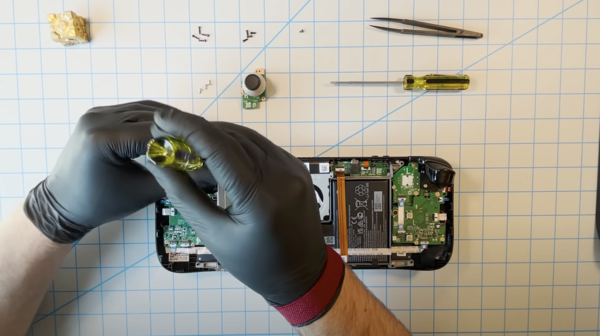
For a repair Valve doesn’t want you to do, they’re sure explaining it really well.
A couple of years ago, Microsoft showed off a version of its Surface Laptop that could be opened up by a technically inclined person and repaired, even upgraded, if needed. Rather than making things hard, the company made it possible. (Sure, not great—iFixit only gave them a 5/10—but possible is still better than nothing.)
But when he showed off the device’s ability to be repaired, the company’s chief product officer, Panos Panay, made a point of discouraging people from randomly tearing apart this device just because they could.
“Don’t try that, OK? Don’t do that,” he said. “Don’t call me or send me the tweet that says, ‘I tried to rip the top off and now it’s broken and it’s your fault.’”
It was a strange statement—an admission that the company was taking right to repair seriously, but not that it wanted any knucklehead with a screwdriver to actually do it.
Now, two years later, we have a new video from Valve, makers of the deservedly hyped Steam Deck, essentially telling its target audience the same thing in a new video.
To be clear, it is an excellent video, one that correctly shows how to unscrew the device and do the two things purchasers of the device are likely to do—remove the joy-cons, and upgrade the SSD. But the unseen person on the clip is repeatedly explaining why Valve doesn’t want you to open it.
“Even though it’s your PC (or will be once you’ve received your Steam Deck), and you have every right to open it up and do what you want we at valve really don’t recommend that you ever open it up,” the pair of arms tells its viewers. “The Steam Deck is a very tightly designed system and the parts are chosen carefully for this product with its specific construction so they aren’t really designed to be user-swappable.”
This is such a damn interesting trend, and one I actually hope becomes a bigger deal in the years to come. By companies admitting, hey, this is not something we’d recommend the average user do, but still telling you how to do it, Valve is helping to please the lawyers, explain why things are done the way they are, but then also ensuring that the reality of people using their computers in not-quite-warranty-supported ways isn’t blocked off.
Valve is offering an NVMe drive that comes in an uncommon size and was specially designed to not create any interference with other parts in the machine, and if you remove it, you lose something. Same if you replace a screen in an iPhone—the water resistance is never going to be the same. But a stern warning combined with possibility is still significantly better than solder holding down storage in a ball grid array, making it nearly impossible to replace without being at risk of destroying the thing entirely.
This is actually a positive thing for right to repair. (As I recently learned the hard way, leaning too hard on a figurehead for right to repair may not be a positive thing for right to repair.) Making it possible to take something apart to fix or upgrade it, even if they don’t want you to do so, is far better than locking everyone out with glue and solder, making it difficult or impossible to even make the repair even if you wanted to.
And that, my friends, is a trend that needs to continue.
Time limit given ⏲: 30 minutes
Time left on clock ⏲: 6 minutes, 45 seconds



